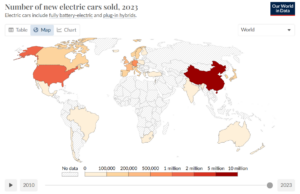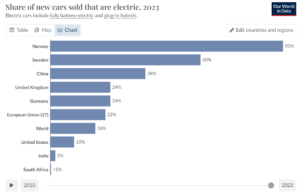
The global electric vehicle market has become a critical component in the transition towards a low-carbon future. At the forefront of this revolution is China, whose rapid ascent in the EV industry has left global automakers scrambling to keep pace. Despite trade tensions and tariffs aimed at curbing its dominance, China remains the undisputed leader in the sector, producing more than 60% of the world’s EVs.
China’s success in the electric vehicle industry can be traced back to a combination of forward-thinking policies, substantial investments, and a national commitment to innovation. The story begins with a strategic proposal made by Wan Gang, often referred to as the father of the EV movement in China. His vision, presented to the Chinese State Council in 2000, emphasised the need for China to develop clean energy technologies to gain an edge over global competitors in the automotive industry.
READ I A nation in the dark: Census delay risks India’s future
Policy-driven electric vehicle revolution
The Chinese government responded enthusiastically to this proposal, making the development of EVs a national priority. This government support manifested in large-scale investments, with over $60 billion funnelled into the EV sector between 2009 and 2017. The rapid growth of the industry is striking: in 2011, just 1,000 battery-powered and hybrid cars were sold in China, but by 2023, this figure had skyrocketed to 9.49 million.
The Chinese government played a crucial role in creating the necessary ecosystem for the EV sector by developing infrastructure, supporting research and development, and offering subsidies to local manufacturers like BYD and Nio. These policies laid the foundation for China’s dominance in the global EV market.


The results of these efforts have been profound. Chinese automakers are not only competing with traditional global giants but are outpacing them in terms of technological advancements. Companies like Nio, BYD, and Xpeng are producing vehicles that are not only affordable but are also packed with features that appeal to tech-savvy consumers. The shift in consumer preferences is evident, as buyers increasingly prioritise advanced technology, such as voice control and artificial intelligence, over traditional automotive hallmarks like horsepower and handling.
Affordability of EVs
One of the key drivers of China’s success in the EV market has been the intense competition among its domestic manufacturers. This competitive environment has spurred rapid innovation and brought down production costs, making Chinese EVs more affordable than those produced by Western manufacturers. For instance, in 2023, the cost of EV batteries in China fell by 50%, and the price of solar panels dropped by 42%. These reductions in cost have not only benefitted Chinese consumers but have also made China’s clean energy products attractive on the global market.
The aggressive competition within China’s domestic market has also fostered a culture of continuous technological innovation. Chinese EVs, equipped with cutting-edge technology, offer features that many Western competitors struggle to match.
For instance, Nio’s ET5 is equipped with a luxurious interior design, smooth voice controls, and even personalised features that greet passengers by name. These features resonate strongly with Chinese consumers, who increasingly see local EV brands as superior to traditional luxury brands like Mercedes-Benz and BMW. As a result, German automakers, who once dominated the Chinese luxury car market, are now facing significant losses, with brands like Mercedes experiencing a sharp decline in sales.
China’s ability to produce affordable and technologically advanced EVs has positioned it as a global leader in the industry. This success, however, has come at a time when trade tensions are rising, and other countries are increasingly wary of China’s growing dominance in the clean energy space.
Trade tensions and global impact
Despite its success, China’s dominance in the EV industry has sparked significant concerns among major global economies. In 2024, several countries, including the United States, the European Union, and Canada, imposed higher tariffs on Chinese-made EVs, citing concerns over China’s industrial policies and the potential for overcapacity.
The European Union’s decision to impose tariffs of up to 37.6% on Chinese EVs and the US raising tariffs to 100% highlight the growing trade tensions between China and other major markets. These measures are intended to protect domestic industries from the perceived threat of Chinese competition, but they also risk disrupting global supply chains and stifling innovation.
China has responded to these challenges by defending its policies, emphasising that its industrial strategy is designed to promote low-carbon economic growth. The Chinese government views these tariffs as discriminatory, arguing that they are part of a broader effort by Western countries to contain China’s economic rise. Moreover, China has taken retaliatory measures, including launching anti-dumping investigations and filing disputes with the World Trade Organisation (WTO). While these trade tensions pose challenges, China’s EV industry remains resilient, and its dominance in the sector continues to grow.
Lessons for other countries
China’s success in the EV industry offers valuable lessons for other nations looking to establish or expand their own electric vehicle markets. The first and perhaps most crucial lesson is the importance of long-term strategic planning. China’s ascent in the EV industry was not a result of short-term initiatives but was instead driven by decades of careful planning and government support. Countries that wish to emulate China’s success must adopt a similar approach, prioritising the development of clean energy technologies through sustained investment and policy support.
Secondly, fostering competition within the domestic market is key to driving down costs and encouraging innovation. China’s internal market is highly competitive, with numerous companies vying for market share. This competition has led to rapid advancements in technology and a reduction in the cost of EVs, making them more accessible to consumers. Other countries can benefit from creating similar competitive environments by offering incentives for innovation and supporting local manufacturers.
A third lesson is the need to focus on technological advancements rather than relying on traditional automotive strengths. Established automakers in Europe and the US have been slow to adapt to the EV revolution, often clinging to the outdated internal combustion engine model. In contrast, Chinese companies have prioritised technological innovation, integrating advanced features like artificial intelligence and autonomous driving capabilities into their vehicles. Countries that want to succeed in the EV market must be willing to embrace new technologies and shift their focus away from traditional automotive metrics.
Furthermore, investment in infrastructure is critical to supporting the mass adoption of electric vehicles. China’s success was not only a result of manufacturing prowess but also of the creation of a robust infrastructure network, including charging stations and battery recycling facilities. Governments around the world must recognise the importance of investing in such infrastructure if they hope to achieve widespread EV adoption.
Finally, balancing national policy with global cooperation is essential in today’s interconnected world. While protectionist measures may offer short-term benefits, they risk fragmenting global markets and stifling the development of new technologies. A more effective approach is to foster international collaboration in addressing climate change and advancing clean energy technologies. Countries should pursue multilateral solutions through organisations like the WTO rather than resorting to unilateral tariffs and trade restrictions that only exacerbate tensions.
China’s dominance in the EV market is not just a result of government support and strategic planning but also of its ability to foster competition, embrace technological innovation, and invest in infrastructure. As the rest of the world grapples with the challenge of transitioning to clean energy, China’s success offers a blueprint for how to develop a robust and competitive EV industry. However, the growing trade tensions between China and other major economies threaten to slow down progress in the global fight against climate change.
Rather than focusing solely on containing China’s rise, other nations should consider adopting the strategies that have contributed to China’s success. By embracing long-term planning, fostering innovation, and investing in infrastructure, countries can position themselves as strong players in the global EV market. The future of transportation is electric, and those who fail to adapt risk being left behind.
